The NVIDIA GeForce RTX 2070 Super & RTX 2060 Super Review: Smaller Numbers, Bigger Performance
by Ryan Smith on July 2, 2019 9:00 AM EST- Posted in
- GPUs
- GeForce
- NVIDIA
- Turing
- GeForce RTX
Power, Temperatures, & Noise
Last, but not least of course, is our look at power, temperatures, and noise levels. While a high performing card is good in its own right, an excellent card can deliver great performance while also keeping power consumption and the resulting noise levels in check.
| GeForce Video Card Voltages | |||||
| RTX 2070S Boost | RTX 2070 Boost | RTX 2060S Boost | RTX 2060 Boost | ||
| 1.043v | 1.05v | 1.043v | 1.043v | ||
Looking quickly at boost voltages, there aren’t any big surprises. Like the non-Super cards they’re based on, both of the new Super cards will max out at either 1.043v or 1.05v at their highest boost bin. In reality, these cards are typically not boosting quite so high due to TDP limits, in which case power consumption is often under a volt(a).
| GeForce Video Card Average Clockspeeds | |||||
| Game | RTX 2080 | RTX 2070S | RTX 2070 | RTX 2060S | |
| Max Boost Clock | 1900MHz | 1950MHz | 1875MHz | 1950MHz | |
| Boost Clock | 1710MHz | 1770MHz | 1620MHz | 1650MHz | |
| Tomb Raider | 1785MHz | 1875MHz | 1725MHz | 1800MHz | |
| F1 2019 | 1785MHz | 1875MHz | 1770MHz | 1815MHz | |
| Assassin's Creed | 1815MHz | 1890MHz | 1785MHz | 1860MHz | |
| Metro Exodus | 1785MHz | 1875MHz | 1725MHz | 1815MHz | |
| Strange Brigade | 1770MHz | 1875MHz | 1725MHz | 1800MHz | |
| Total War: TK | 1785MHz | 1875MHz | 1725MHz | 1815MHz | |
| The Division 2 | 1740MHz | 1845MHz | 1680MHz | 1755MHz | |
| Grand Theft Auto V | 1815MHz | 1890MHz | 1785MHz | 1860MHz | |
| Forza Horizon 4 | 1800MHz | 1890MHz | 1785MHz | 1875MHz | |
Meanwhile the average in-game clockspeeds largely echo NVIDIA’s official claims. The new Super cards tend to have higher clockspeeds, owing to their higher starting points within NVIDIA’s specifications. These higher clockspeeds allow these cards to punch a bit harder than they otherwise would, narrowing the gap with their RTX 2080/2070 analogs. The trade-off for this is that TDP becomes a very careful balancing act, as these higher clockspeeds are farther up on the voltage/frequency curve where the underlying GPUs aren’t quite as efficient.
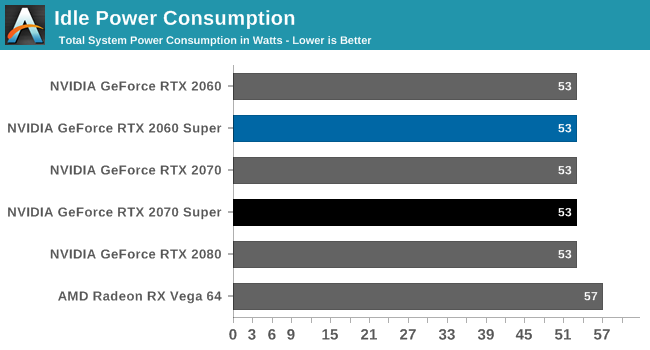
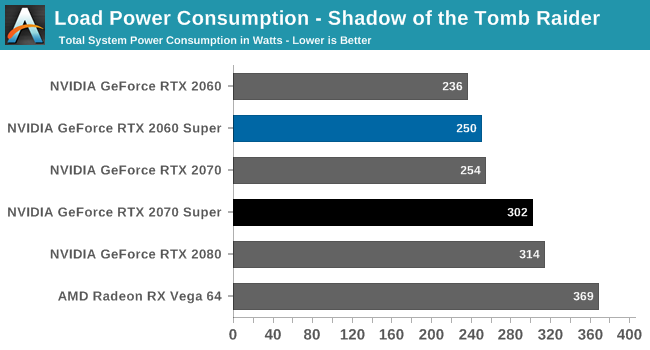
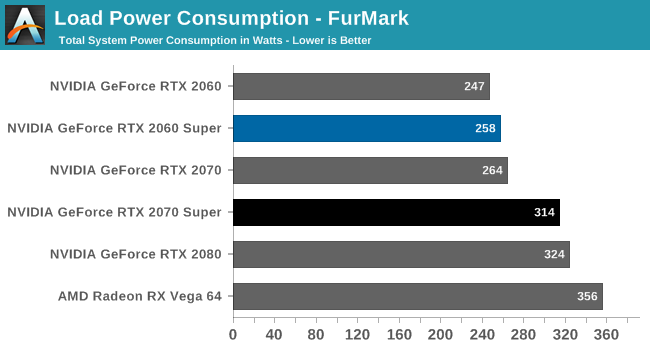
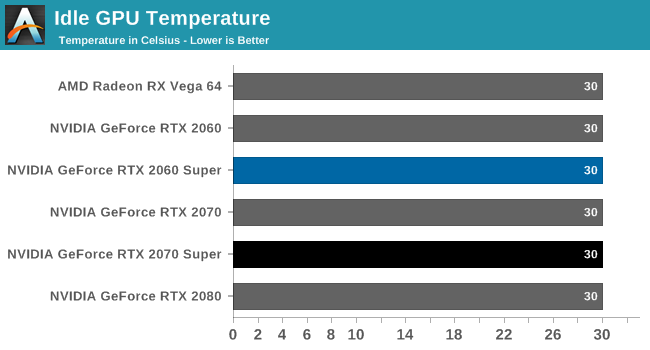
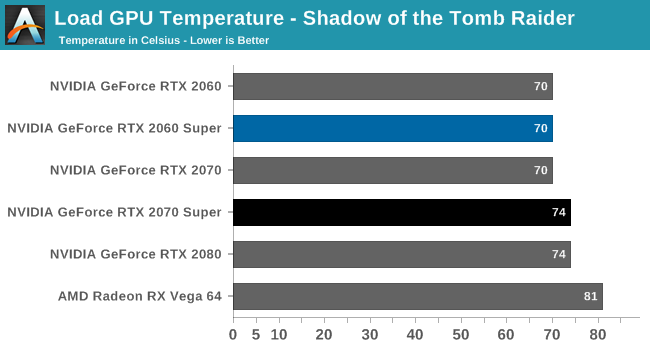
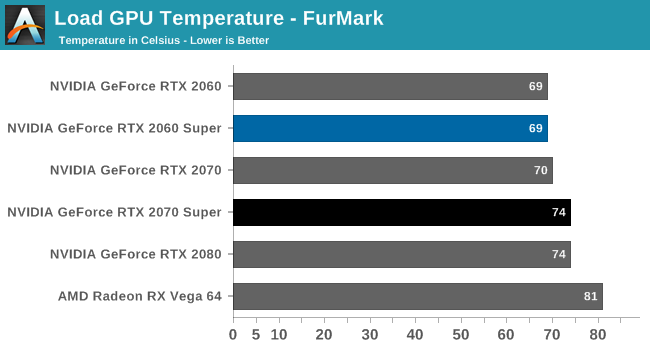
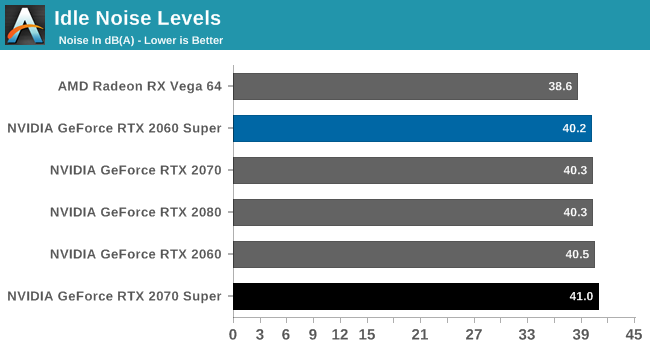
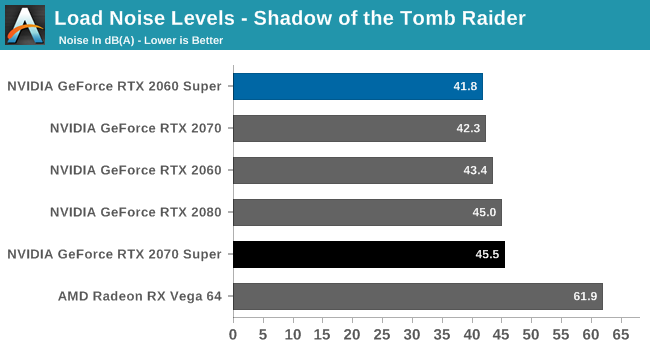
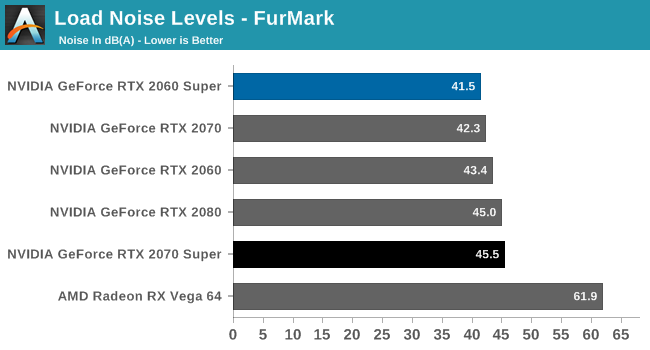










281 Comments
View All Comments
Korguz - Saturday, July 6, 2019 - link
everything thing yojimbo says is fact ?? yea right... thats a laughKevin G - Wednesday, July 3, 2019 - link
Umm... the TU102 dies is 754 mm^2. That is highend fair enough but it is near the limit with only the 818 mm^2 of the GV100 being larger.For consumer parts though? nVidia has routinely used chips larger than 500 mm^2 for the high end products but now a chip that large is being fitted into the RTX 2070 Super. That is still a very big chip that is difficult to yield fully functional units.
As prices for new process nodes goes up, chiplets do offer start to offer advantages in prices as they don't have to be manufactured on cutting edge nodes: if moving 5 nm in the future is not immediately cost effective, wait it out and simply add more 7 nm chiplets for a product refresh. The big advantage new nodes will be bringing is lower power consumption which limits pretty much everything. However, scaling back on clocks and voltage does permit significant power reductions and thus more dies for a given power budget.
eastcoast_pete - Tuesday, July 2, 2019 - link
The big (potential) upside of chiplets is, of course, the ability to make cards of various capabilities simply by connecting more chiplets to the interconnect. Also, there is an inherent upside to making several, smaller building blocks (chiplets) than one large die: you don't have to throw an entire huge die with many billions of transistors out just because of one or two significant defects. Much cheaper. The big challenge is the interconnect fabric: whoever is the first to get that right has a huge advantage.Without any insider knowledge of what's going on at NVIDIA, I would be amazed if they aren't working on their own interconnect and chiplet approach with great intensity.
eva02langley - Tuesday, July 2, 2019 - link
AMD is right now on the third iteration of Infinity Fabric. It is obvious that it is coming in the near future.Threska - Tuesday, July 2, 2019 - link
I'd say both Intel and Nvidia because all three are facing the same challenges as things get smaller.Yojimbo - Wednesday, July 3, 2019 - link
You say much cheaper.. the dies are cheaper, yes. But I don't believe the entire package is cheaper. Not currently, anyway, and they seemingly won't be cheaper if they are build on a silicon interposer so they must be built on other substrate.NVIDIA are working on their own interconnect and chiplet and have been for over 5 years or so, just like everyone else. That doesn't mean they are going to put it on a consumer GPU any time soon. You need the die costs to be pretty high, the interconnect to be pretty energy efficient, and the substrate cost to be low for it to make sense to add such complexity to something that could otherwise be made with one die.
soliloquist - Tuesday, July 2, 2019 - link
Nvidia lowering prices to steal AMD's thunder at launch is nothing new.But I think that it is telling that Nvidia had to crank up TDP and is willing to bundle games to do it. Time will tell exactly how these cards stack up, but it seems very clear that AMD has put the screws to Nvidia to produce more value in the market.
Meteor2 - Saturday, July 6, 2019 - link
Yes, AMD's main achievement is keeping Nvidia honest. But only just.Maxiking - Tuesday, July 2, 2019 - link
RIP AMD again.SD777 - Tuesday, July 2, 2019 - link
Why didn't the article include the specs/comps for the 2080ti? I would have liked to see the 2080ti on those charts so I could compare it. Might have been nice to include some of the 10xx generation just for comparison, but I can understand why those wouldn't be relevant.